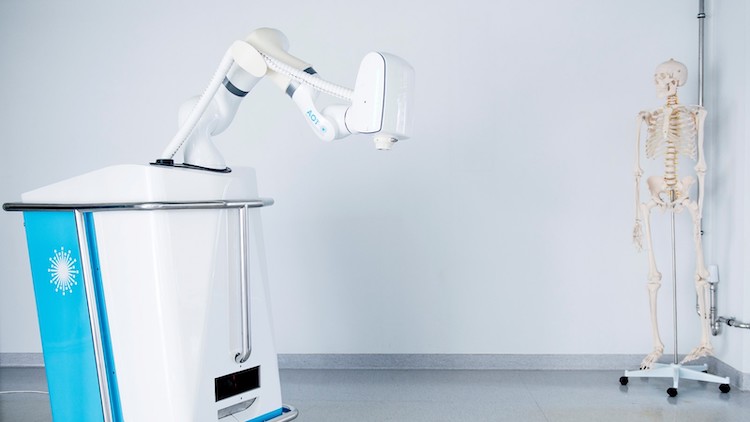
AOT robot ready to cut human bones after passing surgical tests
Advanced Osteotomy Tools says its surgical robot has successfully completed all the surgeries required for the “first-in-man” clinical study of the Carlo device for laser-assisted cutting of human bone.
AOT, a Swiss medical technology company, says the tests were undertaken on June 19, 2020. The aim of the study was to demonstrate the performance and safety of the system.
CARLO, short for Cold Ablation Robot-guided Laser Osteotome, is a surgical robotic platform, which is used to cut bones through cold laser ablation – that is, without conventional surgical tools.
CARLO was used for the first time in July 2019 at the University Hospital in Basel, Switzerland. Since then, laser osteotomies have been used as part of a clinical study during the surgeries of 28 patients at the University Hospital Basel, the Medical University of Vienna (AKH Wien) and the University Hospital Hamburg-Eppendorf.
With the successful completion of the clinical study, AOT aims to achieve a CE marking for its device before the end of the year. The submission of the relevant documentation to the US Food and Drug Administration (FDA) is expected for early 2021.
AOT AG, headquartered in Basel, Switzerland, is the first company worldwide to develop a surgical robotic platform which is able to cut bones using so-called cold laser ablation.
The platform – named CARLO (Cold Ablation Robot-guided Laser Osteotome) – uses pre-planned cutting patterns and a digital workflow to perform osteotomies precisely and completely contactless via laser.
The advantages of laser osteotomy over conventional surgical tools such as saws, drills or mills include arbitrary cutting geometry and patient safety: CARLO can be stopped immediately with the speed of light and can be removed effortlessly, as no mechanical components, which can vibrate or even deform under load, are utilized.
Therefore, the device can be safely and universally applied for all types of bone cuts.
In July 2019, CARLO was successfully used for the first time during a trans-oral mid-face osteotomy.
This surgery also marked the start of the clinical first-in-man study, which had the goal of confirming the performance and safety of the technology in a clinical context.
The University Hospital Basel, the Medical University of Vienna (AKH Wien) and the University Hospital Hamburg-Eppendorf participated in the study, during which 28 surgeries were performed using CARLO.
Due to a delay caused by the Covid-19 crisis, the last surgery took place on June 19, 2020.
The preliminary findings of the study are impressive already: the freely definable cutting patterns allow for alternative surgical techniques, which protect bone structures and accelerate the healing process.
Assistant Professor Dr Gabriele A. Millesi, president of the International Association of Oral and Maxillofacial Surgery, says: “For us, as team of the Department of Maxillofacial Surgery at the Medical University of Vienna, it was both very important and an honour to participate in an impressive chapter of innovative intra-operative surgical technology.
“With success and confidence, we were able to use the CARLO technology on a patient collective with skeletal dysgnathia of varying degrees of severity, with very satisfactory results for us as surgeons as well as for our patients.
“The future of ‘Cold Ablation Robot-guided Laser Osteotomy’ will lie in the high precision and the individually designable cutting patterns. The successful first-in-man study has opened the door for this.”
The full, final report of the findings is currently being compiled. Based on this report, AOT is aiming to achieve a CE marking for CARLO before the end of the year, which enables the company to market and sell its technology in Europe.
In early 2021, AOT also plans to submit all relevant documentation to the FDA as part of the so-called De Novo process.
In addition to facial surgery, AOT is also currently testing other areas of application for the CARLO technology, for example in the fields of spinal surgery and neurosurgery, with further areas of indication planned.
In addition, the further technical development of the technology is being advanced as well: the three current focus areas of research and development are more powerful lasers, the cutting of skin tissue and the use of artificial intelligence for real-time analysis of diseased and healthy bone tissue during the cutting process.
Cyrill Bätscher, CEO of AOT, says: “The successful completion of the first-in-man study is a big success for us. We were able to show the enormous potential of contactless, robotic surgery based on laser technology and the improvements it offers for patients.
“This brings us one large step closer to our next milestone – achieving a CE marking.”
